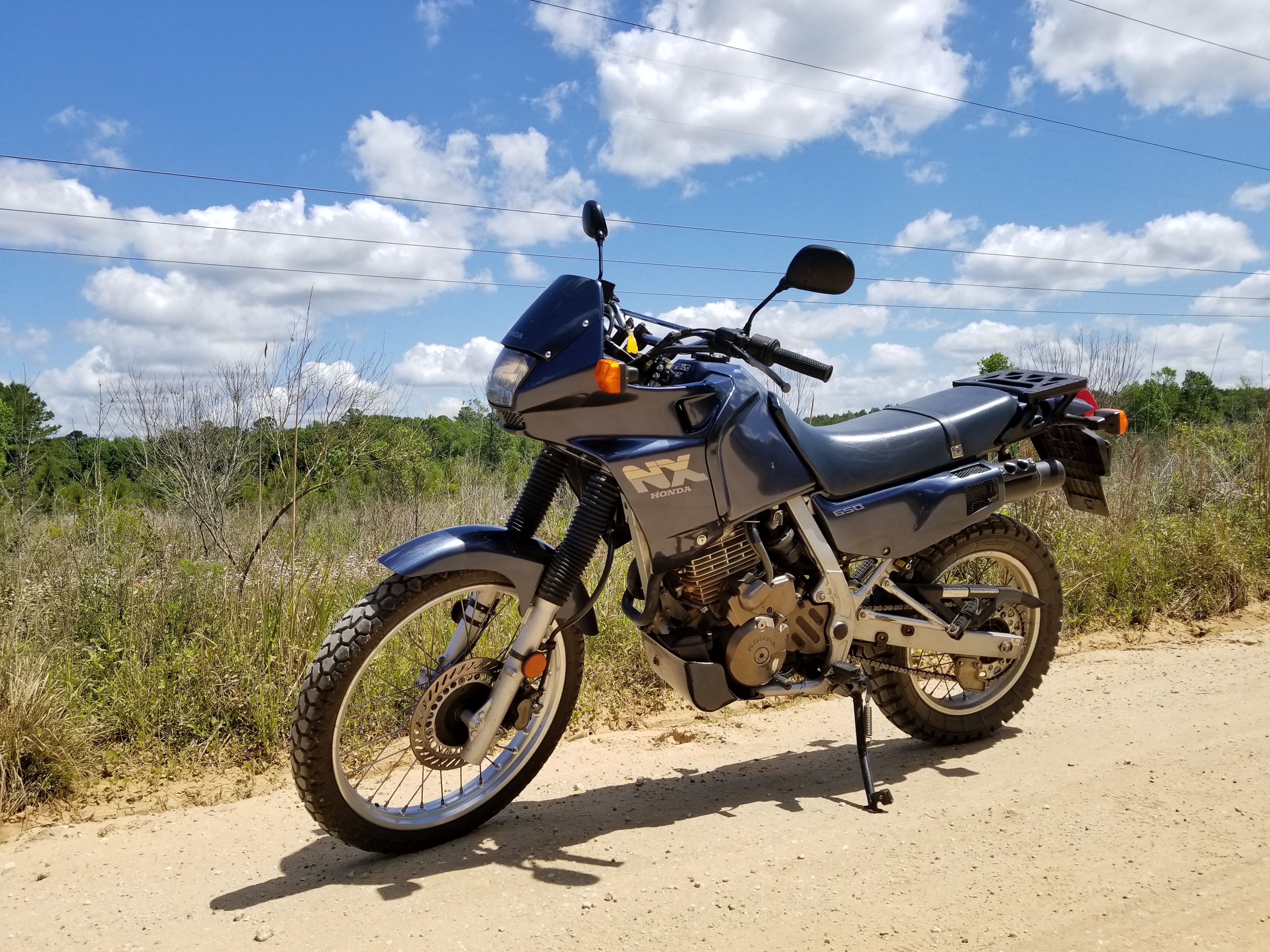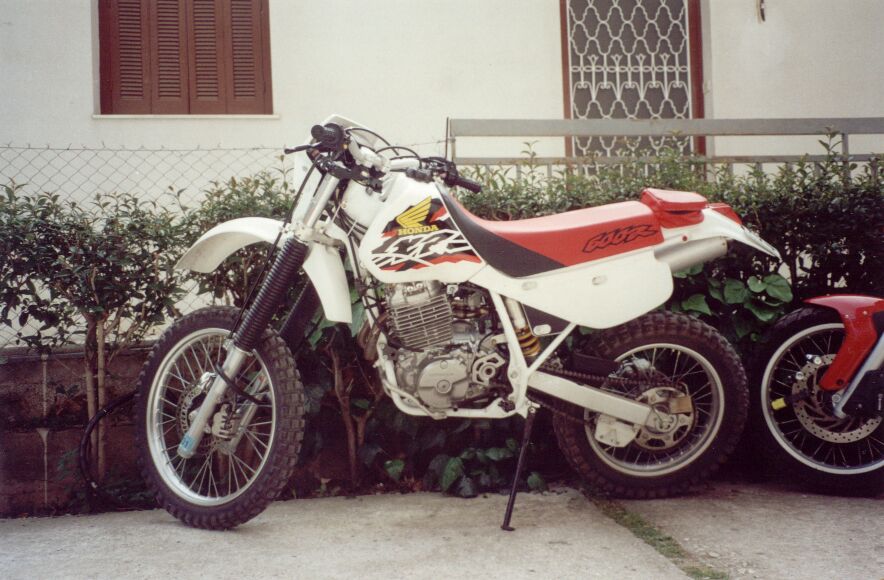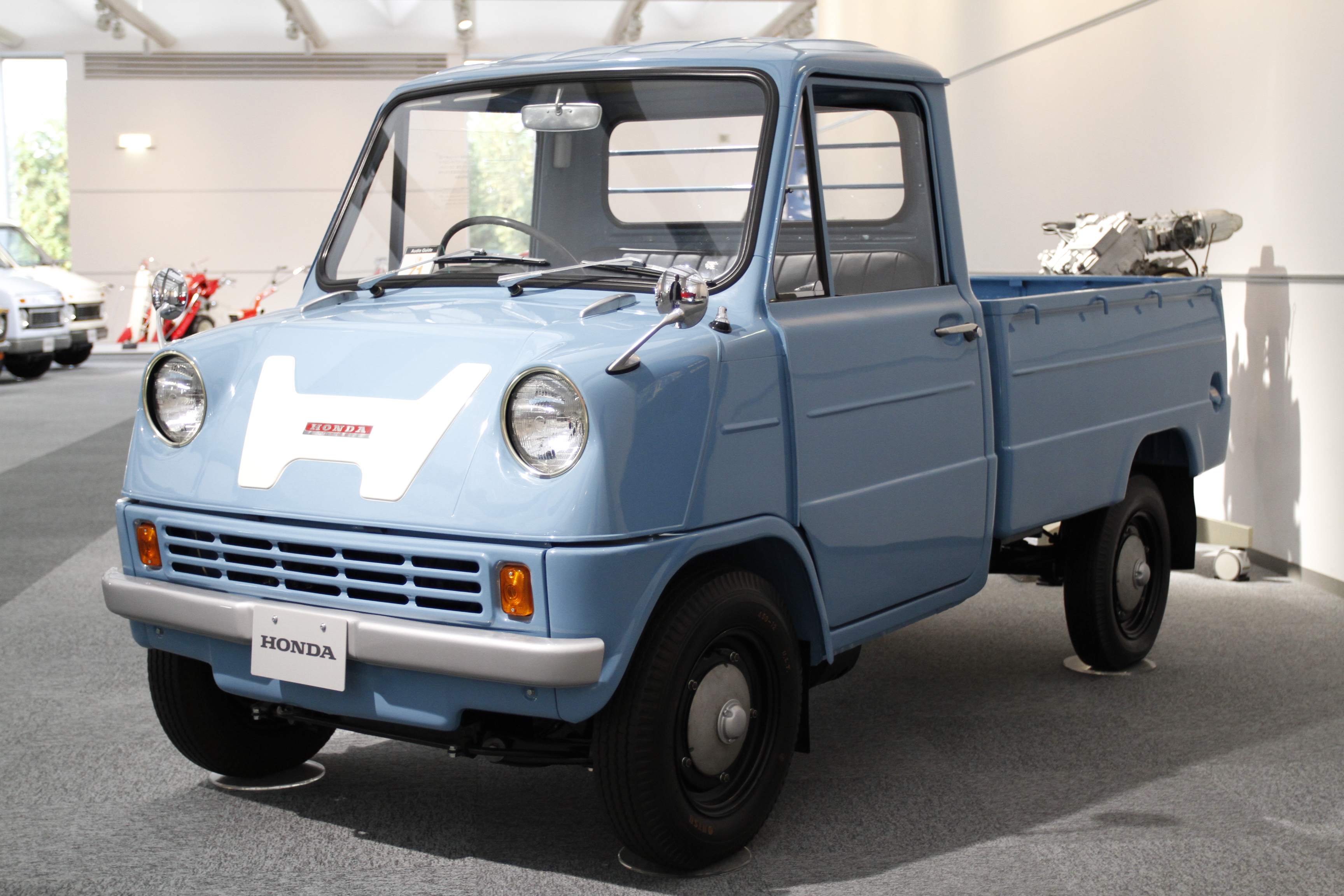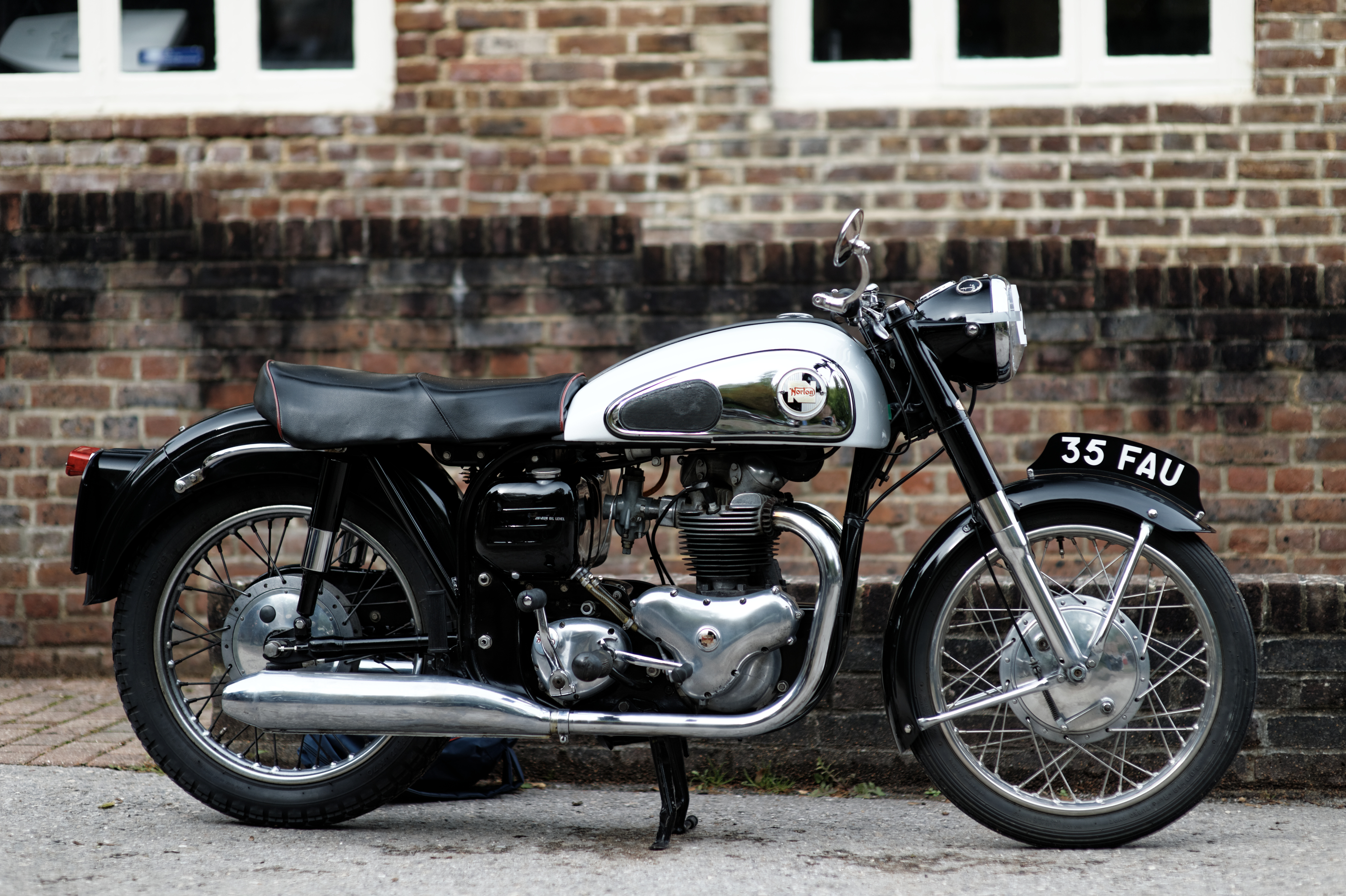|
Honda NX650 Dominator
The Honda NX650 Dominator is a dual-sport motorcycle. It was manufactured by Honda from 1988 to 2003. Between this period, several variants of the model were released with different fairing designs or changes to the mechanical systems. Reference can be seen to RD02 for early models or RD08 for later models. Design Its engine is slightly larger than that of the XR600L, which debuted in 1985. The 97mm bore engine was enlarged to 100 mm and stroked from 80 to 82mm for 644cc. With 44 horsepower at 6,000 rpm, the engine had 53 N⋅m of torque at 5,000 rpm. A gear-driven counterbalancing system helps to smooth out vibrations created by the large single-cylinder engine. The compression ratio of 8.3:1 for the four valves is aided by a single chain-driven overhead camshaft. The intake is via a 40 mm Keihin constant-velocity carburettor, reaching as low as 5.2 L/100km (45 mpg) from 12.8 liters (3.4 gallons) in the tank. The bike features a dry-sump (frame carries oil supply) engine. Th ... [...More Info...] [...Related Items...] OR: [Wikipedia] [Google] [Baidu] |
Honda XR600
The Honda XR600R was an offroad dual-sport motorcycle powered by an air-cooled single cylinder, four-stroke engine, manufactured by Honda from 1985 to 2000, and is part of the Honda XR series. The currently available road oriented XR650L model is similar to the XR600R with an engine of more displacement but lower compression and less horsepower. The engine displacement is 591 cc with four valves placed in a RFVC (Radial Four Valve Combustion) radial disposition with a single camshaft. It has a dry sump lubrication system. The engine has a compression of 9.0:1 with a bore/stroke of 97 × 80 mm. The engine is fed by a 39 mm piston-valve carburetor A carburetor (also spelled carburettor or carburetter) is a device used by a gasoline internal combustion engine to control and mix air and fuel entering the engine. The primary method of adding fuel to the intake air is through the Ventu .... The front suspension is managed by two conventional cartridge v ... [...More Info...] [...Related Items...] OR: [Wikipedia] [Google] [Baidu] |
Honda Motorcycles
commonly known as just Honda, is a Japanese multinational conglomerate automotive manufacturer headquartered in Minato, Tokyo, Japan. Founded in October 1946 by Soichiro Honda, Honda has been the world's largest motorcycle manufacturer since 1959, reaching a production of 500 million . It is also the world's largest manufacturer of internal combustion engines measured by number of units, producing more than 14 million internal combustion engines each year. Honda became the second-largest Japanese automobile manufacturer in 2001. In 2015, Honda was the eighth largest automobile manufacturer in the world. The company has also built and sold the most produced motor vehicle in history, the Honda Super Cub. Honda was the first Japanese automobile manufacturer to release a dedicated luxury brand, Acura, on 27 March 1986. Aside from their core automobile and motorcycle businesses, Honda also manufactures garden equipment, marine engines, personal watercraft, power generators, an ... [...More Info...] [...Related Items...] OR: [Wikipedia] [Google] [Baidu] |
Disc Brake
A disc brake is a type of brake that uses the #Calipers, calipers to squeeze pairs of #Brake pads, pads against a disc (sometimes called a [brake] rotor) to create friction. There are two basic types of brake pad friction mechanisms: abrasive friction and adherent friction. This action slows the rotation of a shaft, such as a vehicle axle, either to reduce its rotational speed or to hold it stationary. The energy of motion is converted into heat, which must be dissipated to the environment. Hydraulic brakes, Hydraulically Actuator, actuated disc brakes are the most commonly used mechanical device for slowing motor vehicles. The principles of a disc brake apply to almost any rotating shaft. The components include the disc, master cylinder, and caliper, which contain at least one cylinder and two Brake pad, brake pads on both sides of the rotating disc. Design The development of disc-type brakes began in England in the 1890s. In 1902, the Lanchester Motor Company designed bra ... [...More Info...] [...Related Items...] OR: [Wikipedia] [Google] [Baidu] |
Exhaust Gas
Exhaust gas or flue gas is emitted as a result of the combustion of fuels such as natural gas, gasoline (petrol), diesel fuel, fuel oil, biodiesel blends, or coal. According to the type of engine, it is discharged into the atmosphere through an exhaust pipe, flue gas stack, or propelling nozzle. It often disperses downwind in a pattern called an ''exhaust plume''. It is a major component of motor vehicle emissions (and from stationary internal combustion engines), which can also include crankcase blow-by and evaporation of unused gasoline. Air pollution from burning fossil fuels is estimated to kill over 5 million people each year. Motor vehicle emissions are a common source of air pollution and are a major ingredient in the creation of smog in some large cities. Composition The largest part of most combustion gas is nitrogen (N2), water vapor (H2O) (except with pure-carbon fuels), and carbon dioxide (CO2) (except for fuels without carbon); these are not toxic or noxiou ... [...More Info...] [...Related Items...] OR: [Wikipedia] [Google] [Baidu] |
Carburettor
A carburetor (also spelled carburettor or carburetter) is a device used by a gasoline internal combustion engine to control and mix air and fuel entering the engine. The primary method of adding fuel to the intake air is through the Venturi effect or Bernoulli's principle or with a Pitot tube in the main metering circuit, though various other components are also used to provide extra fuel or air in specific circumstances. Since the 1990s, carburetors have been largely replaced by fuel injection for cars and trucks, but carburetors are still used by some small engines (e.g. lawnmowers, generators, and concrete mixers) and motorcycles. In addition, they are still widely used on piston-engine–driven aircraft. Diesel engines have always used fuel injection instead of carburetors, as the compression-based combustion of diesel requires the greater precision and pressure of fuel injection. Etymology The term ''carburetor'' is derived from the verb ''carburet'', which means ... [...More Info...] [...Related Items...] OR: [Wikipedia] [Google] [Baidu] |
Multi-valve
A multi-valve or multivalve Four-stroke engine, four-stroke internal combustion engine is one where each Cylinder (engine), cylinder has ''more than two'' poppet valve, valves – more than the minimum required of one of each, for the purposes of air and fuel intake, and Exhaust system, venting exhaust gases. Multi-valve engines were conceived to improve one or both of these, often called "better breathing", and with the added benefit of more valves that are smaller, thus having less mass in motion (per individual valve and spring), may also be able to operate at higher revolutions per minute (RPM) than a two-valve engine, delivering even more intake an/or exhaust per unit of time, thus potentially more power (physics), power. Multi-valve rationale Multi-valve engine design A multi-valve engine design has three, four, or five poppet valves per cylinder, to achieve greater performance. In automotive engineering, any four-stroke internal combustion engine needs at least two v ... [...More Info...] [...Related Items...] OR: [Wikipedia] [Google] [Baidu] |
Single-cylinder Engine
A single-cylinder engine, sometimes called a thumper, is a piston engine with one cylinder. This engine is often used for motorcycles, motor scooters, motorized bicycles, go-karts, all-terrain vehicles, radio-controlled vehicles, power tools and garden machinery (such as chainsaws, lawn mowers, cultivators, and string trimmers). Single-cylinder engines are made both as 4-strokes and 2-strokes. Characteristics Compared with multi-cylinder engines, single-cylinder engines are usually simpler and compact. Due to the greater potential for airflow around all sides of the cylinder, air cooling is often more effective for single cylinder engines than multi-cylinder engines. This reduces the weight and complexity of air-cooled single-cylinder engines, compared with liquid-cooled engines. Drawbacks of single-cylinder engines include a more pulsating power delivery through each cycle and higher levels of vibration. The uneven power delivery means that often a single-cylinder en ... [...More Info...] [...Related Items...] OR: [Wikipedia] [Google] [Baidu] |
Torque
In physics and mechanics, torque is the rotational analogue of linear force. It is also referred to as the moment of force (also abbreviated to moment). The symbol for torque is typically \boldsymbol\tau, the lowercase Greek letter ''tau''. When being referred to as moment of force, it is commonly denoted by . Just as a linear force is a push or a pull applied to a body, a torque can be thought of as a twist applied to an object with respect to a chosen point; for example, driving a screw uses torque to force it into an object, which is applied by the screwdriver rotating around its axis to the drives on the head. Historical terminology The term ''torque'' (from Latin , 'to twist') is said to have been suggested by James Thomson and appeared in print in April, 1884. Usage is attested the same year by Silvanus P. Thompson in the first edition of ''Dynamo-Electric Machinery''. Thompson describes his usage of the term as follows: Today, torque is referred to using d ... [...More Info...] [...Related Items...] OR: [Wikipedia] [Google] [Baidu] |
Engine
An engine or motor is a machine designed to convert one or more forms of energy into mechanical energy. Available energy sources include potential energy (e.g. energy of the Earth's gravitational field as exploited in hydroelectric power generation), heat energy (e.g. geothermal), chemical energy, electric potential and nuclear energy (from nuclear fission or nuclear fusion). Many of these processes generate heat as an intermediate energy form; thus heat engines have special importance. Some natural processes, such as atmospheric convection cells convert environmental heat into motion (e.g. in the form of rising air currents). Mechanical energy is of particular importance in transportation, but also plays a role in many industrial processes such as cutting, grinding, crushing, and mixing. Mechanical heat engines convert heat into work via various thermodynamic processes. The internal combustion engine is perhaps the most common example of a mechanical heat engine in wh ... [...More Info...] [...Related Items...] OR: [Wikipedia] [Google] [Baidu] |
Motorcycle
A motorcycle (motorbike, bike; uni (if one-wheeled); trike (if three-wheeled); quad (if four-wheeled)) is a lightweight private 1-to-2 passenger personal motor vehicle Steering, steered by a Motorcycle handlebar, handlebar from a saddle-style seat. Motorcycle designs vary greatly to suit a range of different purposes: Long-distance motorcycle riding, long-distance travel, Motorcycle commuting, commuting, cruising (driving), cruising, Motorcycle sport, sport (including Motorcycle racing, racing), and Off-roading, off-road riding. Motorcycling is riding a motorcycle and being involved in other related social activities such as joining a motorcycle club and attending motorcycle rally, motorcycle rallies. The 1885 Daimler Reitwagen made by Gottlieb Daimler and Wilhelm Maybach in Germany was the first internal combustion, petroleum-fueled motorcycle. In 1894, Hildebrand & Wolfmüller became the first series production motorcycle. Globally, motorcycles are comparable numerically t ... [...More Info...] [...Related Items...] OR: [Wikipedia] [Google] [Baidu] |
Disc Brake
A disc brake is a type of brake that uses the #Calipers, calipers to squeeze pairs of #Brake pads, pads against a disc (sometimes called a [brake] rotor) to create friction. There are two basic types of brake pad friction mechanisms: abrasive friction and adherent friction. This action slows the rotation of a shaft, such as a vehicle axle, either to reduce its rotational speed or to hold it stationary. The energy of motion is converted into heat, which must be dissipated to the environment. Hydraulic brakes, Hydraulically Actuator, actuated disc brakes are the most commonly used mechanical device for slowing motor vehicles. The principles of a disc brake apply to almost any rotating shaft. The components include the disc, master cylinder, and caliper, which contain at least one cylinder and two Brake pad, brake pads on both sides of the rotating disc. Design The development of disc-type brakes began in England in the 1890s. In 1902, the Lanchester Motor Company designed bra ... [...More Info...] [...Related Items...] OR: [Wikipedia] [Google] [Baidu] |










